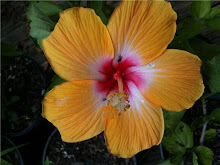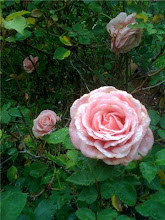

While walking the property outside, I thought I'd take a close look of the ground and see what was springing up. To my delight, I noted baby cleavers growing, baby mullein growing and lots of verbena growing. How exciting - I've been looking forward to the cleavers coming since saying goodbye to it last summer. I can hardly wait to drink a cleavers infusion and make fresh cleavers lotion!
Here's a little information on Cleavers, Mullein and Verbena:
Cleavers (Galium aparine): Grows in part sun part shady areas with lots lose soil and organic matter on the ground. Mine grows just under the rose gardens amongst all the fallen rose petals and leaves. The soil is very rich in decaying organic matter. It loves to grow close to the ground and when you touch it the leaves feel as if they touch you back...they feel a bit sticky due to tiny little hooked hairs on the slender juicy pinnate leaves. It is not a native, but it is abundant and invasive to some. Europeans originally used it every Spring to cleanse their blood and help stimulate glandular and liver function. Now, people all over the world like to make a tea out of this yummy herb and drink it for the same purpose.
Cleavers is easy to harvest. It appears as if it is well rooted, but quite the contrary. It is barley rooted to the ground and just grows and climbs along. When you pick up one leaf, you are able to practically pick up the entire plant!
Cleavers can be infused in oils and made into salves and lotions. It can be made into tincture and infused into a tea. It can be cooked in soups and used much like a vegetable. It has an earthy fresh flavor. It can be juiced in a juicer and drank as a super green morning drink to get you revved up in the mornings. A shot or small amount is all you need, since it is a cleanser - you may get loose stools if you consume too much at one time. I like to drink a cup of Cleavers infused tea once a day in the Spring time. It seems to help clean the system of impurities and clear the face of blemishes. To make an infusion, boil a couple of cups of water and once it comes to a boil, take it off the heat and add a handful of the herb into the pot. Infuse for about 15 minutes, strain, and then drink the infusion. It is very light green and is pleasant to the pallet.
Mullein (Verbascum thapsus): Mullein is a medicinal herb often used to ease inflammation in the respiratory tract and with alleviating mucousy coughs. People infuse mullein with hot water to make a tea and consume it to ease irritation and inflammation. I have infused dried mullein leaves in extra virgin olive oil to make an oil infusion which is good for relieving ear aches in children and adults. Just a couple of drops of the oil is what people use to help ease the discomfort; however it is not for eardrums that have broken - it is simply for basic ear aches.
The oil also has anti-microbial properties. I have made salves and lotions with mullein infused oils. It is very soothing to the skin.
I just love walking along and finding mullein on my path. It is so soft and velvety. I find it very inviting and as I look down into the plant, the leaves seem to draw me in.
Vervain (Verbena glandularia):
Vervain covers the field where I live....in the Spring the ground is covered with its blue/purple flowers. A tincture can be made of Vervain by harvesting the aerial parts. It is best to harvest the aerial parts before the flowers open. It is a nervine tonic used to strengthen the central nervous system. It's actions are sedative, anti-spasmodic, & diaphoretic. Simpler's method is the easiest, in which you fill a jar full of plant material and pack it in tight. Then pour vodka into the jar; ensuring all the plant matter is submerged. Cover the jar and store in a cool/dark location and shake each day. After a couple weeks, strain the mestrum (exhausted and depleted plant material) and the plant free liquid that is left is your new tincture!
People take drops of the tincture as it is regarded to aid with sleep, digestion and inflammation of muscles. Most people, who use the tincture, use it to rest easier and ease away tension and anxiety. They use it as a sleep aid. I recently read that people use it when muscles are spasming or inflamed. As a diaphoretic, it has been used with fevers. People have also turned to Vervain to help reduce inflammation of the gall bladder. It has also been used as a mouthwash to assist with gum inflammation.
























+and+wildflowers+loving+the+field.jpg)







